Low-Carbon Roads to Resilience: Sahel’s Strategy for Rural Logistics and Development
The World Bank’s report presents a strategic, nine-module framework to transform rural logistics in the Sahel through low-carbon, climate-resilient investments. It aims to boost food security, market access, and regional stability by integrating infrastructure, green technology, and institutional reforms. Ask ChatGPT

In a region where climate volatility, poverty, and conflict converge, the Sahel faces an uphill battle for development. Stretching across countries like Senegal, Mauritania, Mali, Burkina Faso, Niger, and Chad, rural areas remain the most exposed to the compounding effects of environmental degradation and institutional fragility. Recognizing this critical juncture, the World Bank’s 2025 report, Low-Carbon and Climate-Resilient Rural Logistics in the Sahel: Strategic Framework for Investment Planning, offers a bold, data-driven roadmap to transform the region’s logistics backbone into a vehicle for climate resilience, food security, and inclusive growth.
Led by transport experts Guillermo Diaz-Fanas and Fatima Arroyo Arroyo, the report aims to rethink how development finance and policy can unlock the Sahel’s untapped potential, particularly in rural zones where access to markets, infrastructure, and basic services remains a daily struggle.
The Climate-Conflict Trap: A Sahelian Reality
The Sahel is experiencing a relentless rise in extreme weather: searing heat, devastating floods, and creeping desertification. These trends are pushing agricultural systems to the brink, jeopardizing food security for millions. Simultaneously, protracted conflict, political instability, and weak institutions have rendered much of the region highly fragile. As climate change exacerbates social inequalities and territorial tensions, the resulting feedback loop, conflict undermining governance, and weak governance amplifying climate vulnerability, make meaningful progress elusive.
In this setting, poor infrastructure is not just a logistical challenge; it’s a barrier to survival. Farmers cannot move their goods; health workers cannot reach isolated communities; businesses cannot grow. These gaps isolate entire populations and restrict access to opportunity. Rural logistics, therefore, are not peripheral; they are the lifelines of resilience.
A Strategic Framework with Nine Building Blocks
The report introduces a comprehensive nine-module investment planning framework to address this crisis. Anchored in five key principles, context-specific design, low-carbon approaches, integrated supply chains, hard-soft synergy, and data-led decision-making, the strategy is both flexible and robust.
The first three modules assess development baselines, identify regional barriers and opportunities, and map out potential investment solutions. These use composite indices combining data on demographics, human welfare, trade activity, and environmental risks to provide a nuanced understanding of each region’s development stage.
Modules 4 through 6 evaluate investment options across logistics nodes (e.g., storage and processing centers), road infrastructure (such as all-weather roads), and logistics fleets (ranging from non-motorized vehicles to electric trucks). These are assessed for their cost-efficiency, feasibility, and climate compatibility.
The final three modules focus on institutional and technological enhancements, investment impact assessments, and cost-benefit analysis. They offer a monitoring framework using key performance indicators (KPIs) that span 10 development priorities, from employment generation to food security and climate adaptation.
Greening the Supply Chain, One Link at a Time
Rather than focusing solely on large-scale roadbuilding, the framework emphasizes building resilient logistics networks that serve the entire supply chain, from farm to market. It encourages co-located investments, such as combining solar-powered warehouses with charging stations for electric vehicles. In areas with limited electrification, short-term strategies like leasing low-emission vehicles are proposed to avoid long-term fossil fuel lock-in.
The report also urges investments in both “hard” and “soft” infrastructure, pairing physical construction with trade facilitation, governance reforms, and local capacity building. Recommendations include modernizing customs procedures, incentivizing private sector logistics services, and expanding institutional support for rural cooperatives and women-led enterprises.
Notably, climate risk assessments are embedded in every stage of planning. Using future climate scenarios (SSP2-RCP4.5 and SSP5-RCP8.5), the framework anticipates how different warming trajectories could impact infrastructure, agricultural productivity, and water availability, ensuring that projects are designed to endure shifting environmental baselines.
Real-World Applications: Chad, Burkina Faso, Niger
The framework’s practicality is showcased in deep-dive case studies from Lake Chad (Chad), the SKBo triangle (Burkina Faso), and the Maradi-Zinder-Diffa corridor (Niger). In these regions, integrated investment plans were developed to address specific local needs, from flood-prone trade routes to remote agricultural hubs lacking cold chains.
For instance, in Chad, the strategy focused on post-harvest storage, flood-resilient road segments, and institutional reforms to improve cross-border trade with Cameroon and Nigeria. In Niger, solar-powered depots and small EV fleets were proposed to reduce transport costs for farmers. Each of these projects demonstrated a benefit-to-cost ratio between 2.3 and 5.5, remarkable figures in such high-risk contexts.
These case studies illustrate that under the right conditions, climate-smart rural logistics investments are not just feasible, they’re highly impactful. They create jobs, reduce post-harvest losses, enhance food security, and promote peace by improving livelihoods and reducing social grievances.
A Roadmap for Inclusive, Sustainable Recovery
Ultimately, this report underscores a critical message: climate-resilient rural logistics are not a luxury for the Sahel; they are a necessity. The proposed investment framework is not just about building roads or acquiring vehicles. It’s about enabling human mobility, market participation, and institutional trust in places that have long been left behind.
By combining targeted infrastructure investments with institutional reforms, green technologies, and careful climate foresight, this framework offers a replicable model for regions facing similar challenges. It’s a call to donors, policymakers, and private investors alike: with the right tools and strategies, even the most fragile geographies can unlock sustainable, inclusive growth. The Sahel, long seen through the lens of crisis, can become a proving ground for low-carbon development done right.
- FIRST PUBLISHED IN:
- Devdiscourse
ALSO READ
Amazonia Bonds Platform Launched by IDB and World Bank to Drive Green Finance
Pioneering Climate Resilience: NCDEX and IMD's Landmark Weather Derivatives Initiative
Sevilla Summit Highlights Urgent Need to Scale Climate Resilience Financing
Pioneering Climate Resilience: NCDEX and IMD's Strategic Weather Derivatives Launch
Rwanda Launches $9M Ecosystem Restoration Project to Boost Climate Resilience










